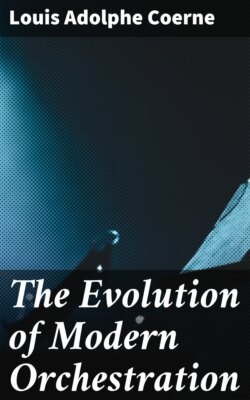Читать книгу The Evolution of Modern Orchestration - Louis Adolphe Coerne - Страница 36
III.
ОглавлениеItaly. In the previous chapter, the progress of orchestration in relation to its beneficent guardian, the drama, was traced from the improvements initiated by Monteverde through those of Scarlatti. These new doctrines were, of course, assiduously seized upon by the latter's contemporaries and immediate successors. But indeed it was not until the advent of Spontini as late as the first part of the nineteenth century that Italian orchestration was again represented by an exponent of more than secondary importance, taking into consideration the achievements of Rameau in France, not to mention the great German masters. For Pergolesi excelled particularly in string writing, whereas Cherubini's scoring shows German influence rather than Italian. Nevertheless, Neapolitan propagandism exerted world-wide influence, and was directly fostered by such men as Buononcini, Durante, Porpora, Leo, Logroscino, all of whom were born in the last quarter of the seventeenth century; to the same chronological period belongs also Lotti (1667), a worthy representative of the Venetian School, who, although primarily a composer of sacred music of marked individuality, wrote a number of operas for Venice as well as several for Dresden and Vienna. Having resided for two years in Dresden, he aided the diffusion throughout Germany of operatic and orchestral principles that were conspicuously Italian even if not specifically those of Naples. Like him, Durante devoted himself almost exclusively to sacred writing. Leo, though producing many dramatic works as well as oratorios and chamber music, aided the advance of Italian art more as the teacher of Jomelli and Piccini than by his creations. Both G. Buononcini and the singing teacher, Porpora, were through the irony of fate led to aid artistic evolution by negative means, so to speak, since the trend of their ambitions brought them face to face with the genius of Händel, upon whom their machinations acted but as a stimulus. For, as will be remembered, Buononcini's defeat in London was followed fifteen years later by a second unsuccessful rivalry instigated by Porpora's faction. Logroscino is to be remembered for his development of opera-buffa and of the Finale as subsequently applied by Piccini. But it is clearly evident that none of these representative Italian composers contributed materially to orchestration with the exception that their instrumental accompaniments acquired greater freedom.
The brief career of Pergolesi (1710-1736) was consummated during the interim dating approximately from Gluck's birth to Haydn's. His fame is confined not alone to his sacred works, such as the Stabat Mater, but to his dramatic productions as well, of which the finest example is, of course, "La serva padrona," of opera-buffa propinquities. His proclivity for employing an orchestra of strings alone, as exemplified in the above mentioned representative works, was fortunate in that thereby he was able to concentrate his thoughts upon finish and detail, such as served as a valuable model for the period in which he was living, when string writing was as yet at an immature stage.
